U.S. EHS Regulatory Trends in 2016
Jan 31st, 2016 | By Lawrence B. Cahill | Category: Environmental Management
“The care of human life and happiness, and not their destruction, is the first and only object of good government.” Thomas Jefferson
Over the past few years there has been much discussion about how companies go about establishing and achieving sustainability and social responsibility objectives. Unless one is careful these initiatives can result in overlooking the need to meet the fundamental objective of regulatory compliance. There is no country where this is more important than the United States where the environmental, health, and safety (EHS) regulatory burden is substantial and the consequences of non-compliance can be quite severe. In order to merit a “license to operate” in the U.S. it is important to understand clearly and completely the regulatory environment and its requirements. This environment is changing constantly as evidenced by the trends discussed in this article. Highlights include:
- Federal EHS regulations continue to grow and now amazingly approach 30,000 pages. Environmental regulations represent almost 90% of the total. Regulations in the pipeline as of late 2015 suggest that this number is likely to grow.
- Both EPA’s and OSHA’s budgets have remained stable in recent years with EPA’s budget being roughly 10 times that of OSHA’s. Thus, there is continued congressional support for both agencies.
- EPA’s US$ 405 million in civil and enforcement penalties in fiscal year 2015 were 2.5 times those in the previous year. Interestingly enough, this represents almost 70% of OSHA’s entire annual budget.
In sum, the challenges are still present for the regulated community operating in the U.S. as regulations continue to be burdensome and the consequences of non-compliance severe.
U.S. EHS Federal Regulations Continue to Grow
Each year the U.S. Government publishes the Code of Federal Regulations (CFRs), effective on July 1st of that year. The individual volumes for each year are usually available in January or February of the following year. The EPA is responsible for Title 40 of that Code and OSHA is responsible for Title 29. In early 2016, the EPA and OSHA released the 2015 CFRs effective July 1, 2015. The total page count for EPA in 2015 was 26,241, the largest on record. (See Figure 1) Combined with OSHA’s 3,147 pages in Title 29 there were over 29,000 pages in total with EPA regulations accounting for 89% of the total. And the beat goes on.
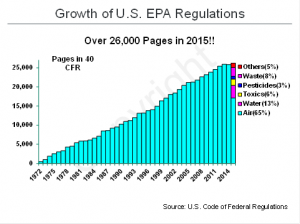
Figure 1
It’s important to note that approximately 65% of the pages in Title 40 of the CFR are devoted to Clean Air Act regulations. This represents roughly 17,000 pages, meaning that the Clean Air Act alone has 5 times as many pages of regulations than the entire Title 29 CFR. Water regulations, governed by the Clean Water Act and the Safe Drinking Water Act, account for only 13% of Title 40. The bottom line is that federal air regulations are massive and in many cases complex and confusing. This is a case where more is not necessarily better.
What Might the Future Hold?
One could ask the question – Will the total page count ever decrease substantially? That’s hard to say although this is possible where duplicative or outdated regulations are eliminated. As an example, on November 19, 2015, EPA and OSHA issued their Fall 2015 Semi-Annual Regulatory Agendas (as part of the Executive Branch’s Unified Agenda) in the Federal Register, which is a spring and fall requirement for all regulatory agencies[i]. The EPA listed 188 additional regulations (not pages, but regulations) that either had been recently promulgated (but not yet codified) or were under development. OSHA listed only 35 regulations in its agenda, so the EPA will likely keep its substantial lead in regulatory page count. (See Figure 2)
Eventually, all of these new regulations will be added to Titles 29 and 40, suggesting that there is no end in sight. It is very interesting to note that each of EPA’s Semi-Annual Regulatory Agendas from 1999 to 2011 listed somewhere between 350 and 450 regulations under development, a consistency that is stunning. This means that for over a decade, there were always around 400 regulations under development on the docket. Interestingly, there has been a dramatic reduction in the number of regulations listed to roughly 200 from years 2012 to 2015. Maybe the regulatory pipeline is beginning to empty.
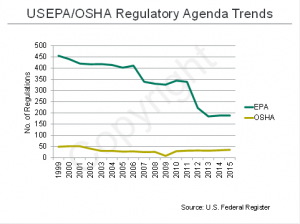
Figure 2
It is notable that on January 18, 2011 President Obama issued Executive Order 13563, “Improving Regulation and Regulatory Review”. The Order required a government-wide review of existing rules “to remove outdated regulations that stifle job creation and make our economy less competitive. It’s a review that will help bring order to regulations that have become a patchwork of overlapping rules…”[i] At long last, there reportedly was a government-wide review of existing regulations to determine those that should be eliminated. The recent U.S. EPA Regulatory Agendas and the low growth of regulations in the most recent Title 40 CFR seem to confirm that the Executive Order might be having the intended impact.
U.S. EPA and OSHA Budgets – A Comparison
From 2010 to 2016, the EPA’s budget declined by approximately 21%, from its peak of US$ 10.3 billion in 2010 to US$ 8.1 billion this fiscal year. This has been a decline, but the allocated budget has remained stable for the past five years at around US$ 8 billion. (See Figure 3)
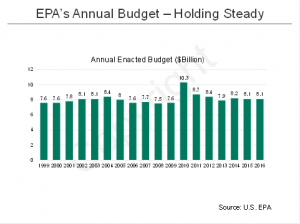
Figure 3
What is even more interesting, however, is comparing OSHA and EPA budgets. As shown in Figure 4, EPA’s budget is about 14 times that of OSHA’s. And even more startling is that EPA’s enforcement budget alone is around 35% larger than OSHA’s entire budget!
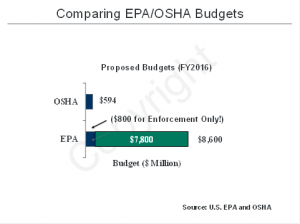
Figure 4
U.S. EPA Enforcement Trends
In late 2015, the EPA released its enforcement results for fiscal year 2015, which ended on September 30, 2015. Included in those results were data on civil and criminal penalties assessed. (See Figure 5) As shown, EPA issued US$ 405 million in civil and criminal penalties in FY2015, which may not seem like much compared to the US$ 5.6 billion issued in FY2013. However, the great majority of the penalties issued in that year were due to 2010 the Deepwater Horizon incident. Still, by comparison the US$ 405 million is 2.5 times greater than the FY2014 results and represents almost 70% of OSHA’s entire annual budget.
It’s difficult to draw a definitive conclusion from the 2015 results. Still, with almost a billion dollars being spent by EPA on enforcement, it remains a serious issue, unmatched by any other country. As EPA has stated in its FY 2013 OECA National Program Manager Guidance, we will “aggressively go after pollution problems that make a difference in communities. EPA will use vigorous civil and criminal enforcement that targets the most serious water, air and chemical hazards, as well as advance environmental justice by protecting vulnerable communities”.[i]
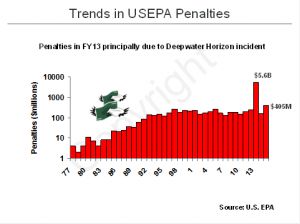
Figure 5
Closure
Equipped with the information presented in this article, corporate EHS managers and leaders can better convince their senior leadership teams that the EHS regulatory landscape remains complex, and the consequences of non-compliance are significant and likely not going away. With the Republicans now controlling both houses of Congress and the upcoming 2016 presidential election, the future of EHS regulations today remains complex and an ever-changing mystery. Stay tuned…
Author’s Note
This article is an update of Chapter 2 in Environmental, Health and Safety Audits: A Compendium of Thoughts and Trends, Bernan Press, Lanham, MD, 2015.
About the Author
Lawrence B. Cahill, CPEA (Master Certification) is a Technical Director with Environmental Resources Management and has over 35 years of professional EHS experience with industry and consulting. He is the editor and principal author of the widely used text, Environmental, Health and Safety Audits, 9th Edition and its 2015 follow-up text EHS Audits: A Compendium of Thoughts and Trends, both published by Bernan Press. He has published over 70 articles and has been quoted in numerous publications including the New York Times and the Wall Street Journal. Mr. Cahill has worked in over 25 countries during his career. He holds a B.S. in Mechanical Engineering from Northeastern University where he was elected to Pi Tau Sigma, the International Mechanical Engineering Honor Society. He also holds an M.S. in Environmental Health Engineering from the McCormick School of Engineering and Applied Science of Northwestern University, and an MBA from the Wharton School of the University of Pennsylvania. He is a Certified Professional Environmental Auditor, Master Certification.
Photograph: Tetraeder Kaleidoscope by Night by Oscar Perez
Return to the EHS Journal Home Page
[i] U.S. Environmental Protection Agency, FY 2013 Office of Enforcement and Compliance Assurance (OECA), National Program Manager (NPM) Guidance, April 30, 2012, p. 6
[ii] Obama, Barak, “Toward a 21st-Century Regulatory System”, Wall Street Journal, January 18, 2011.
[iii] The Regulatory Flexibility Act and Executive Order 12,866 require Spring and Fall Regulatory Agendas.

